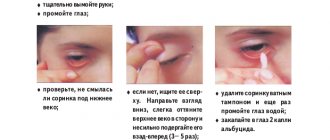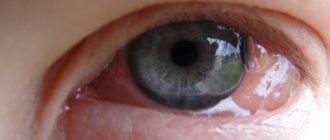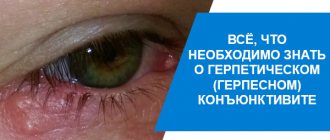What is a chalazion?
A chalazion is a swelling caused by a blockage of the sebaceous gland located behind the eyelashes. This eye disease is often confused with stye. The main distinguishing feature is the appearance of swelling. With barley, the eye does not swell or become inflamed.
The main reason for the appearance of chalazion is advanced stye. When the gland is blocked, the secretion cannot come out, which leads to its accumulation. A capsule forms around the cyst, which may burst. The main question to ask if a chalazion has ruptured is: “How can I get all the pus out?”
At first, the formation of a compaction may occur without symptoms, so it is extremely difficult to detect. However, over time, the tumor begins to grow and an inflammatory process occurs. In the absence of timely treatment at an early stage, the growth will have to be removed surgically.
Chalazion is accompanied by:
- eyelash loss;
- sensation of a foreign body in the eye;
- the appearance of swelling;
- deterioration of vision.
Read on the topic: Is it possible to cure a chalazion of the upper eyelid using folk remedies?
Features of treatment of chalazion in children
Conservative therapy for chalazion includes a lot of approaches and methods, ranging from the so-called. "folk remedies". As a rule, in the early stages, drug treatment includes absorbable ointments and drops; in case of secondary infection, it contains an antibiotic. If there is an infection, heat is contraindicated; in case of a “quiet” chalazion, physiotherapeutic procedures (UHF, ultraviolet radiation) can be prescribed.
In the case of a sufficiently large nodule, the introduction of hormonal anti-inflammatory and absorbable drugs (for example, Kenalog or Diprospan) with a thin needle is considered effective. The traditional treatment for chalazion at the initial stage is hydrocortisone eye ointment in combination with digital massage for a better absorption effect.
Reasons for the breakthrough
Chalazion tends to grow larger due to the constant accumulation of pus inside the gland. The question that worries many people suffering from chalazion is: “Can it break through on its own and leak out?”
Yes, an enlarged lump can rupture. This is accompanied by pain and itching. Bloody discharge and pus flow from the rupture site.
Reasons why a capsule may burst:
- If a person does not begin treatment for a chalazion for a long time, a rupture may occur due to the resulting inflammation.
- If the duct of the sebaceous gland completely stops releasing secretions to the outside.
- If the treatment was incorrect.
- If you have demodicosis - a disease that occurs as a result of parasitism of the sebaceous gland by mites.
What to do if the chalazion has ruptured?
If a cyst spontaneously ruptures, you should not panic and rush to your doctor. First of all, treat the sore eye with an antibacterial agent. Chlorhexidine is suitable for this. Then use any antiseptic.
What to do next? The pus may not completely flow out of the ruptured seal, which is dangerous due to subsequent complications. As soon as the wound has been disinfected, you should immediately go to a specialist. Further actions will be aimed at removing the remaining pus and accumulated secretions from the duct.
The doctor will surgically clean the pouch of excess residue. Next, treatment will be prescribed.
Therapy is prescribed individually to each patient depending on his general condition at the time of diagnosis.
Antimicrobial drugs are prescribed as medications, which need to be used to regularly treat the eyelid.
If it is not possible to visit your doctor, then you need to start treatment yourself, using pharmacological agents and traditional methods. As a compress, apply Levomekol ointment or a cut aloe leaf to the rupture site. You need to keep the compress for an hour. The procedure should be repeated daily until the inflammation and pus are completely removed.
You may be interested in: How to quickly and effectively treat lower eyelid chalazion?
Treatment tactics
The method of therapy, when the chalazion has been opened, is chosen depending on whether all the pus has come out of the cone or not. If the wound is completely cleansed, the goal of treatment is to prevent fistula formation.
If the formation is not completely cleared, a relapse of the disease in a complicated form cannot be ruled out.
Medicines
To cleanse the wound of pus, block the action of infection and speed up healing, the ophthalmologist prescribes the following medications:
- Kenalog. Corticosteroid in suspension form. A dose of 40 mg is administered into the capsule cavity using a thick cannula. This manipulation allows residual pus to be sucked out. The drug is re-administered after two weeks;
- Diclofenac. Eye drops with pronounced anti-inflammatory properties. They are prescribed for partial opening of the chalazion, which is accompanied by a strong inflammatory process. Drops are applied 1 drop up to four times a day for 14 days.
- Dexamethasone. Decongestant drops are prescribed for a week, one in the morning and one in the evening. Simultaneous use of the drug with antibiotics is allowed.
- Boric acid, 2% solution. Disinfects the wound surface, destroys pathogenic flora. To prepare a medicinal solution, 3 g of acid powder is diluted in five tablespoons of water. Wash the affected area twice a day.
- Floxal ointment with antibacterial action. Protects the patient from recurrence of chalazion of the lower eyelid and aggravation of the disease by infection. Place strips of ointment behind the lower eyelid twice a day. The duration of the course is two weeks. For chalazion of the upper eyelid, it is better to use Floxal eye drops, one twice a day.
Physiotherapy
The following procedures will help to avoid complications after a ruptured chalazion:
- medicinal electrophoresis. Improves lymph and blood flow to the affected area. At the site of the chalazion, medicinal components accumulate, due to which the wound heals faster. Electrophoresis is carried out using a special apparatus - a source of direct and pulsating current. The electrodes are plates on which fabric pads soaked in a medicinal solution are placed;
- UHF therapy is the effect of high-frequency current on the inflamed area. Causes tissue heating and destruction of pathogenic flora;
- magnetotherapy. Promotes the resorption of infiltrates, relieves swelling and accelerates healing;
- laser treatment. Effective for preventing complications if the chalazion has opened. Electromagnetic vibrations relieve pain and swelling, fight bacteria on the wound surface, accelerate healing;
- phonophoresis. Combines the effects of acoustic waves and the administration of drugs. Has an anesthetic, anti-inflammatory, regenerating effect.
Traditional treatment
Some traditional medicine recipes will help prevent complications and speed up the recovery of adults and children if the chalazion has broken through. It is important not to use them independently, but only in consultation with your doctor:
- aloe juice It is instilled into the eye, 4 drops every three hours. Before use, agave juice is diluted with water in the same proportion;
- figs 5-7 fruits are brewed in a glass of hot milk and drunk daily after waking up for one to two weeks. The product improves immunity, enriches the body with valuable substances, and helps fight the disease more effectively;
- marshmallow root. 6 g of crushed rhizomes are poured into a glass of water, boiled in a water bath for 15–20 minutes, then infused for 8 hours. The eyes are washed with the finished product to eliminate the consequences of the inflammatory process;
- cabbage leaf Compresses made from cabbage leaves mixed with a chicken egg quickly relieve swelling. The mixture is applied to the painful area for 5-10 minutes for five days.
Chalazion breakthrough in childhood
Many parents are concerned about the question: “What to do if a child has a breakthrough?” The main thing is to treat the wound to prevent infection. The medications can be used the same as for adults, but it should be borne in mind that children's bodies are more susceptible to medications. Before use, make sure that your child does not have any contraindications or adverse reactions to the chosen medication.
In children, chalazion breaks out much less frequently, but the situation should not be left to chance. Be sure to show your baby to an ophthalmologist. Because the lack of timely treatment can lead to vision deterioration.
Under no circumstances should you take any action to force the chalazion to rupture on its own. It is especially unacceptable to pierce the inflamed area. You can introduce harmful microorganisms that will only worsen the current situation.
Can a chalazion rupture on its own and why is it dangerous?
A chalazion is a hard nodule that appears on the eyelid. A pathological formation appears when the meibomian gland canal is blocked. Her secret cannot come out. It accumulates inside the duct and causes a nodule to appear until it ruptures. Common external and internal causes of the condition are metabolic disorders due to endocrine pathologies, dermatological skin lesions, and improper functioning of the gastrointestinal tract.
From the outside, the seal looks like a pea. It does not hurt when palpated or moved from side to side. If the formation is not treated, purulent fluid accumulates inside it. Over time, the pus no longer fits and breaks out.
Opening a chalazion at home is dangerous; there is a risk of infection. If the seal has ruptured, treat the wound.
If you continue to ignore the problem, the situation threatens the development of unpleasant processes. Without appropriate intervention, colonization of the inflamed area by pathogenic microorganisms occurs. Further reluctance to undergo treatment results in abscesses and phlegmons of the face.
Consequences of chalazion rupture
Why is a breakthrough dangerous? If clots of pus remain inside the wound, an inflammatory process may begin, gradually moving to the eyeball. This can lead to repeated relapse and the emergence of additional pathologies, the treatment of which will take a lot of time. For example, an abscess is an infectious disease characterized by an accumulation of pus.
In addition, a ruptured chalazion has a number of complications:
- redness of the white of the eye;
- blurred vision;
- pain in the eye;
- itching
You may be interested in: Modern methods of chalazion removal and stages of procedures
Prevention
To prevent further complications, you must adhere to the following rules:
- Visiting public places during a flu epidemic is not permissible.
- It is necessary to restore the immune system through proper nutrition, taking vitamins and giving up bad habits.
- You should not be overtired and often be in stressful situations.
- Hypothermia must be avoided.
- You should maintain facial hygiene and massage your eyelids daily.
Causes of the disease
The risk group includes children from five to ten years old; they are the ones who most often become the target of “attack” by harmful bacteria.
The neoplasm manifests itself as an independent disease or is a consequence of recently suffered illnesses that have significantly weakened the immune system. The most common causes of chalazion development are:
- Infection. It is enough to touch your eyes a couple of times with dirty hands and germs will penetrate the body;
- Diabetes;
- Skin problems (most often inflammation begins in children with oily epidermis);
- Hypothermia;
- Weakening of the immune system due to past illnesses.
Frequent recurrence of barley can also provoke chalazion.
Reviews about the treatment of ruptured chalazion
Christina, 30 years old
At the age of 7, a child developed a chalazion, which burst after home treatment. The doctor prescribed Diclofenac drops. They dripped for several weeks in combination with various ointments and compresses from aloe leaves. Everything went without consequences. There was a small scar left on the eyelid.
Evgeniy, 48 years old
A chalazion has formed on the eye. I didn’t want to have surgery, so I was treated with medications. At night I put a baked slice of onion on the sore eyelid. The tumor shrank but did not go away. A month later she broke through. I treated my eye with a disinfectant and went to the ophthalmologist. He cleaned the rupture site of pus and prescribed Levomekol ointment. After a week, the inflammation and swelling went away. During treatment, the protein periodically turned red.











